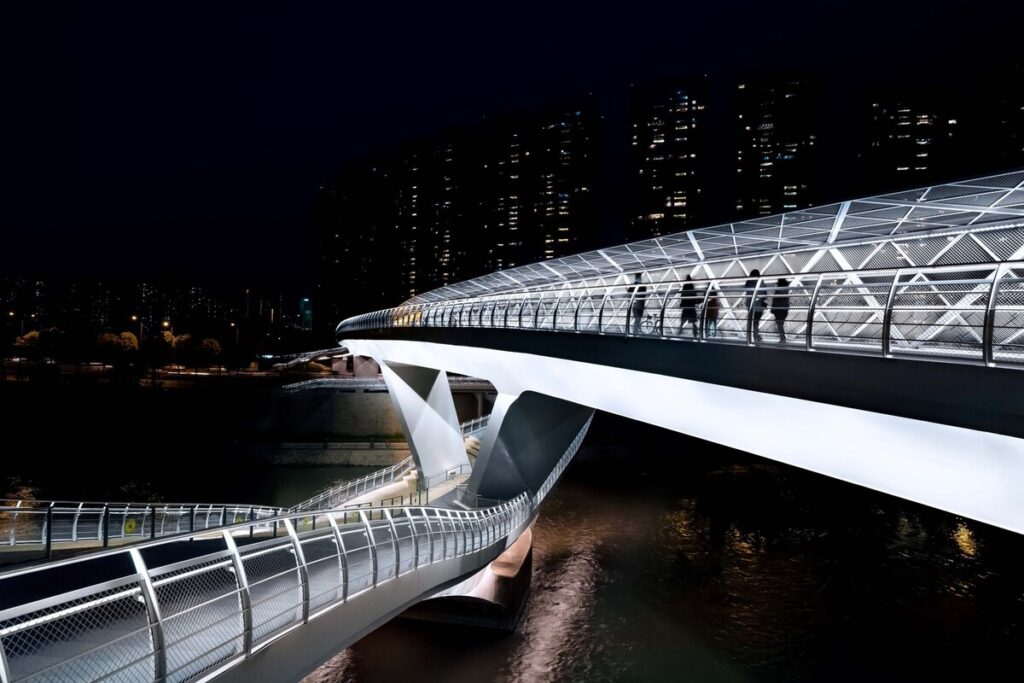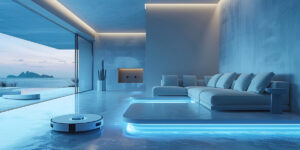The 1960s saw the emergence of the High Tech architectural design movement, which gained significant traction in the 1970s. Supporters of this specific architecture welcomed new methods for engineering and design, with a strong emphasis on structural expressionism and adaptability in design. Among other things, the avant-garde designers of High Tech architectural design delighted in using lightweight materials to create inventive and adaptable interior environments. When the style first emerged, steel, aluminum, glass, and concrete were essential components that helped give High Tech architecture its recognizable appearance.
The late 20th century saw the rise of structural expressionism or High Tech architectural design. The building embodies the essence of the contemporary digital era, with its technological and structural elements prominently showcased. The Lloyds building in London and the Centre Pompidou in Paris are two iconic examples of this architecture.
The Centre Pompidou in Paris, which opened in 1977, is one of the most well-known and almost manifesto-like structures in the style. Two well-known supporters of high tech, Richard Rogers and Renzo Piano, led the design team. Both went on to form their businesses and continue to create works in the same style.
Subsequently, Michael and Patty Hopkins created “Historicist High Tech,” a new, more paradoxical subset of the same aesthetic. Many who were involved in the original metallic High Tech style of the 1970s are revising their designs as technologies continue to stretch the boundaries of design and construction.
Table of Contents
15 Top High Tech Architectural Design Project in the World
Here is a list of the top 15 High Tech architectural design projects in the world worth knowing about:
1. Centre Georges Pompidou
Architects: Renzo Piano Building Workshop, Richard Rogers: Renzo Piano + Richard Rogers
Area: 100000 m²
Year: 1977
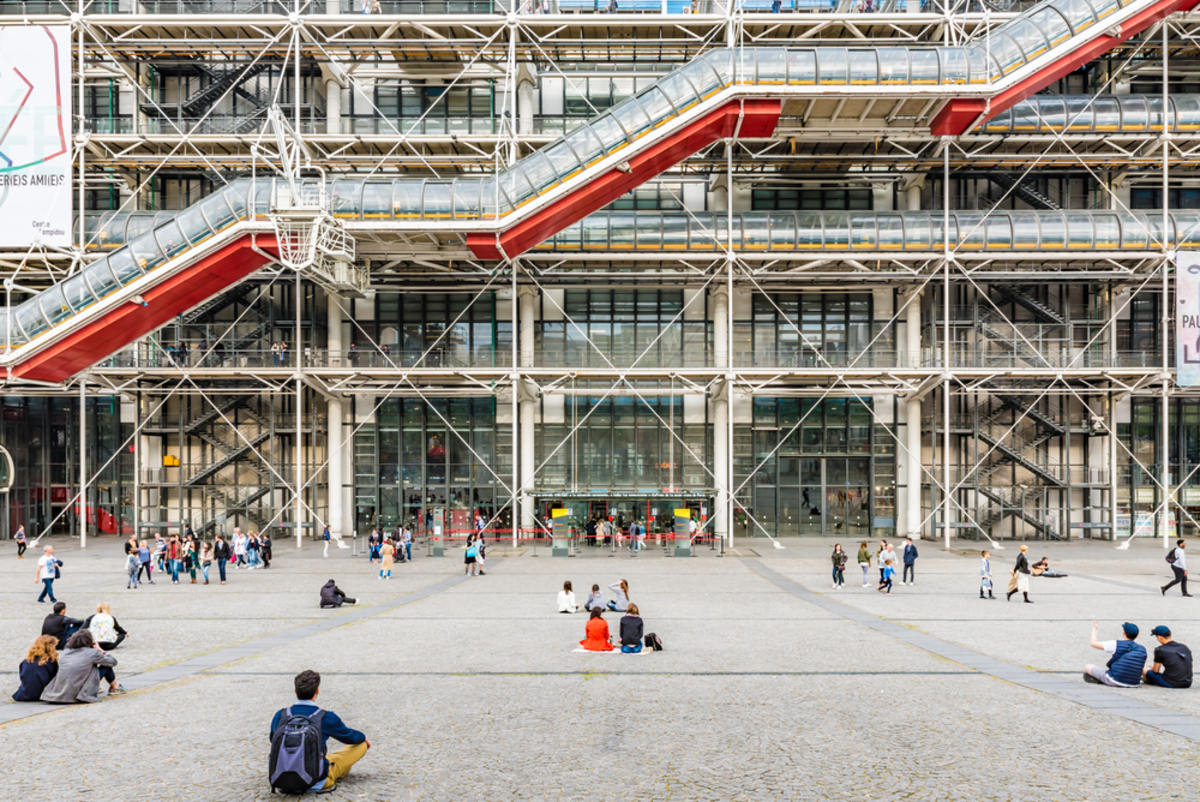
Renzo Piano and Richard Rogers created this High Tech architectural design, one of the most well-known and avant-garde structures of our day, in the 1970s. Our world was practically turned upside down by the cultural center located in Paris, France. It all started with Georges Pompidou, the French president from 1969 to 1974, who envisioned building a major cultural hub in Paris that would draw tourists and be a landmark in the city. With over 150 million visitors since its completion thirty-three years ago, it is undeniable that Pompidou’s vision was carried out to great effect.
The president sponsored a competition to select the architects for the project, and many people entered, including some of the most well-known architects in France at the time. But when the designs by Richard Rogers and Renzo Piano—who weren’t even well-known at the time—won the competition, everyone was shocked. Their submission was a high-tech, contemporary cultural center designed with a system of gerberettes and trusses unlike anything previously seen in the architectural world. It was an exemplary example of constructivism.
Their idea was to represent the museum as a movement, as seen in this collage-style drawing from one of their competition entries. The other, and possibly most evident, idea in their design was to leave this High Tech architectural design’s whole infrastructure exposed. The building’s outside is completely covered by the skeleton, which maximizes the internal space by illuminating all of the many mechanical and structural systems and facilitating their understanding.
Suggested article to read: 11 Innovative Construction Materials; 2024 Review
2. Smart New World Innovation Center
Architects: gad
Area: 89891 m²
Year: 2023
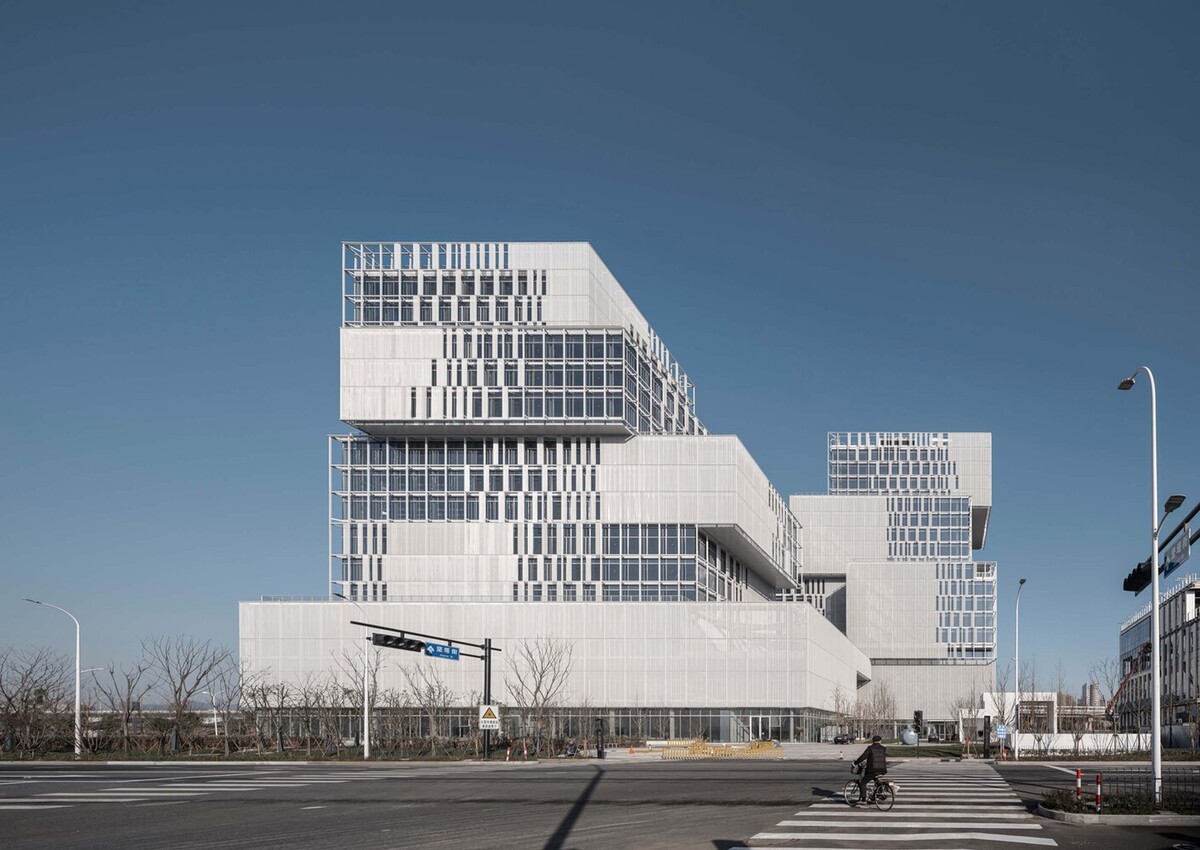
Situated in the Hangzhou High Tech Zone, next to the Zhejiang Bridge and on the north bank of the Qiantang River, is this High Tech architectural design. It is a hub for wisdom industry gatherings and incubation, combining business offices and commercial services, and it will draw high-tech and strategically important rising industries to settle there in the future. The site’s special position and the prospective concentration of certain talents have created demands that are distinct from those of ordinary workplaces.
The base is situated at the Zhejiang Bridge’s entrance to Binjiang. Rolling mountains can be seen across the river, and there are already urban buildings visible along the riverbank. The city’s new construction has lost its connection to nature due to the lack of greenery. They thought of the idea of bringing nature in and modeling the mountain in response to the surroundings. Multiple platforms are generated by dividing the form in a pixelated manner, resulting in a scenario that allows ascending and resting like a natural mountain.
Piecemeal Mountains. To accommodate the demands of various businesses for office space, we constructed two distinct high-rise structures. At the entryway and the river, the towers naturally form two connecting plazas, staggered in front and rear. To reduce mutual interference and achieve the maximum distance between the two buildings, the two towers are positioned floor by floor away from the center of the site, mimicking the piled form of the mountain. Due to the impact of the nearby planned high-rise and the freeway, the setback blocks are further spaced apart; concurrently, a communal viewing platform and roof garden are added to bring nature from the riverbank inside the structure.
Suggested article to read: What is Computational Design? Guide to 2024
3. Whittle School and Studios Suzhou
Architects: Perkins Eastman
Area: 119000 m²
Year: 2022
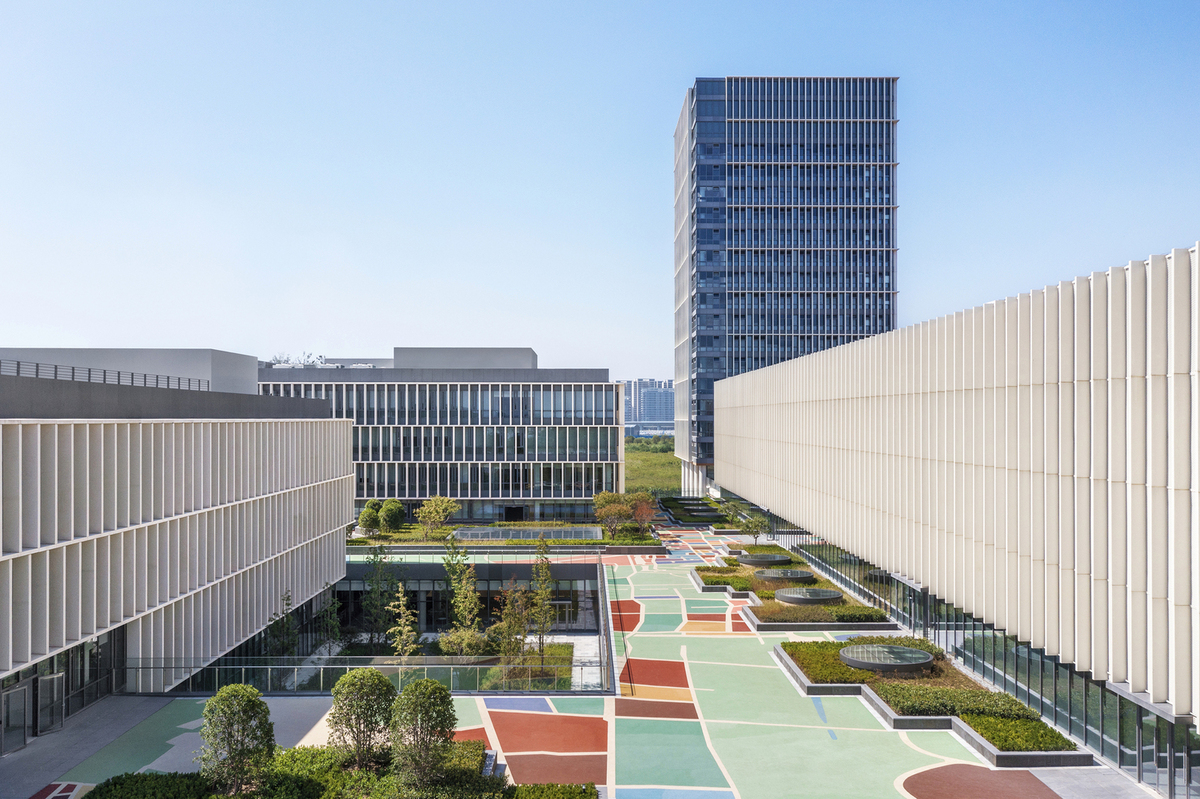
This High Tech architectural design Campus is elegantly located in the center of Suzhou, China’s high-speed rail new town district on a 7.5-hectare waterfront site. The newly constructed 119,000 square meter facility, which is 19 minutes away from Shanghai, is intended to house 2,500 students in grades Pre-K through 12 in a residential school setting that upholds the Whittle tenet that “Learning happens anyplace all the time.”
The campus consists of a 1000-student residential hall, a sports and performing arts center, and multiple academic buildings designed in the courtyard style. High-performing, adaptable learning spaces are provided by the design, which supports transdisciplinary, problem-based project work, bilingual, and experiential learning programs in addition to enhancing Whittle’s core academic curriculum.
With this High Tech architectural design meeting both the China Greenstar (two-star) and LEED for Schools Silver criteria, this brand-new, cutting-edge campus is set to become one of the best boarding school campuses in Asia. The Whittle School campus is planned with both internal programmatic demands and external site constraints in mind. The site is naturally divided into two distinct zones: a boisterous/active/sports/living zone along the highway edge and a serene/contemplative/academic zone bordering the canal. The site is bordered on the east and south by a new waterway/canal, on the north by a secondary access road, and on the west by a highway and green buffer.
Suggested article to read: Client Communication in Construction: Enhanced VR Presentations
4. Chengdu ICON Yunduan
Architects: PES-Architects
Area: 160000 m²
Year: 2017
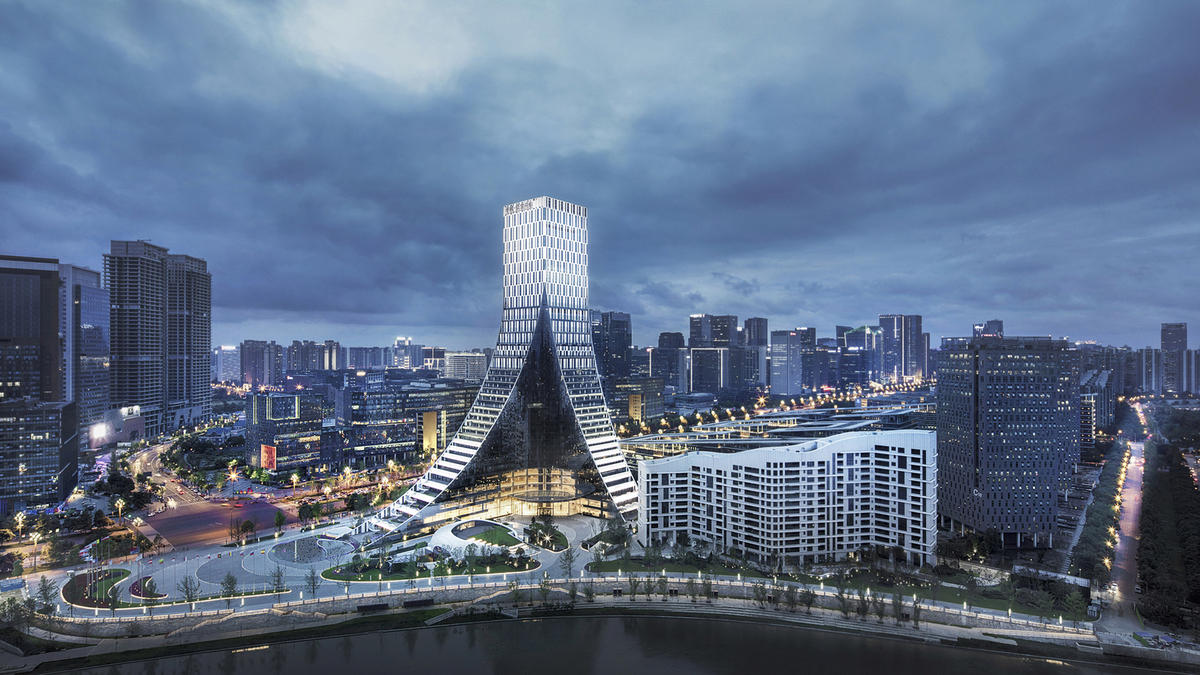
On the outskirts of Chengdu, in the High Tech special zone, sits the hybrid building known as Icon YunDuan. This High Tech architectural design’s goal was to provide a local landmark for the area’s previous building phases as well as a landmark that is apparent as soon as one enters the city.
The proposal is modeled off a 2009 competition entry that won. Three Nordic practices were specially chosen for the competition by the state-owned Chengdu Hi-tech Investment Group. Apart from PES-Architects, other offices that were invited were Helin & Co Architects from Finland and Schmidt/ Hammer/ Lassen Architects from Denmark.
PES-Architects started working with the client and a nearby design firm, China Southwest Architectural Design & Research Institute (CSWADI), to construct the space based on the winning entry as soon as the competition results were revealed. Owing to this High Tech architectural design’s magnitude and constrained timeline, we suggested splitting up the design work, assigning PES-Architects to handle the tower’s general planning and design and Helin & Co. to handle the residential building’s design.
Suggested article to read: Guide to Top 2024 Construction Tech Events
5. J innovation Park
Architects: Chiasmus Partners
Area: 120000 m²
Year: 2021
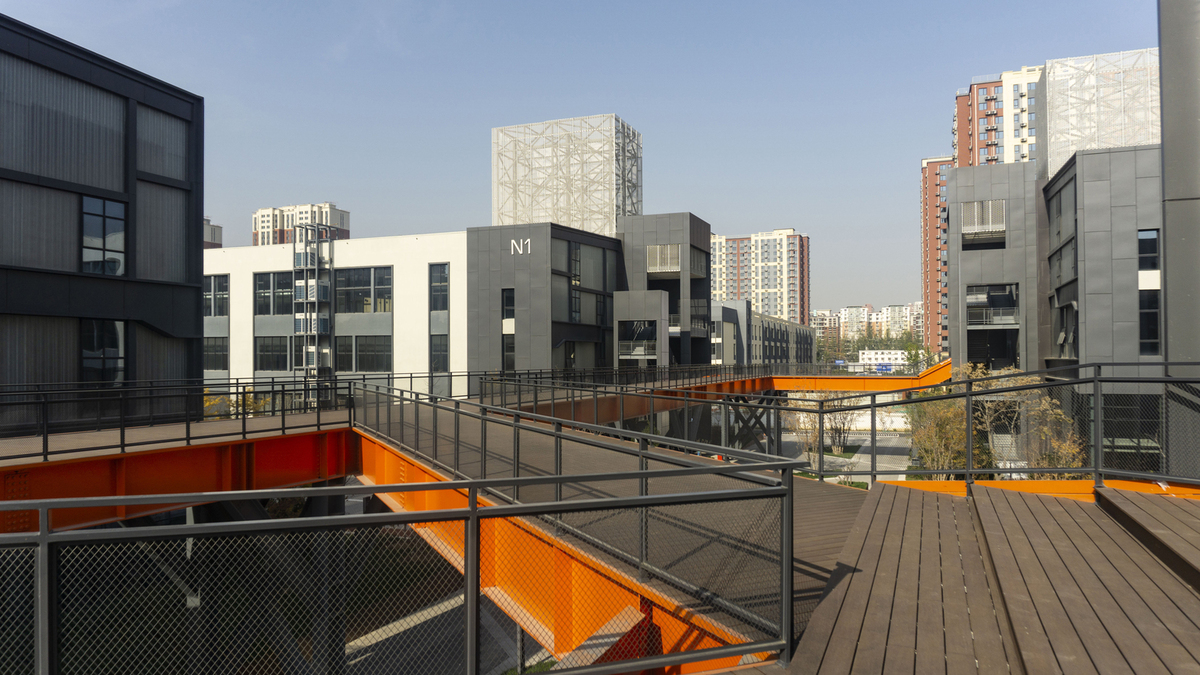
This abandoned furniture factory was transformed into a “High Tech architectural design in the sky.” Once a heavily polluted production area, it has been converted into a robotics industry technical park housing numerous R&D labs and High Tech businesses. Due to its proximity to prestigious colleges and cutting-edge businesses, the 1.2 million square feet of newly restored space at the park were fully occupied.
All renovated buildings are connected by a raised pedestrian walkway that creates an external linkage, akin to Chelsea, New York City’s “high-line” project. The interior street area and open space of the factory were completely renovated, incorporating a new landscape with hidden technology, flexible space, and native vegetation to preserve the building’s historical significance.
A huge gym, one of the greatest indoor climbing areas in the city, marathon running tracks, a multipurpose event space with outdoor theater seating, cafes and cafeterias, and other facilities are all located within the park.
Suggested article to read: Guide to Construction Materials and Latest Innovations in 2024
6. Wuchazi Bridge
Architects: Achim Kaufer and Tom Wünschmann, JDTM, Philipp Buschmeyer and Wei Cai, SCSJ
Area: 4180 m²
Year: 2019

This High Tech architectural design, a vital pedestrian bridge that links the Guixi and Zhonghe subdistricts in this area, is situated by the Jin River in the Chengdu Hi-tech Zone’s southern section. This 4180-square-foot municipal pedestrian bridge has a steel box girder and steel box arch structural design. The idea of the “Infinite ring”—the Mobius—is where the design concept came from. The mathematical symbol for infinity is formed by projecting the infinite form in four-dimensional space abstractly into three-dimensional space. This symbol stands for the Chengdu High-tech Zone, where the bridge is situated, and all of its boundless development potential.
The main bridge and auxiliary bridge include the two sections of the bridge body in terms of structure. The major bridge, which links bike lanes on both banks of the river, is 346.89 meters long and 4.65 to 9.88 meters wide. The audience can enjoy a distinct space with the auxiliary one, which is 208.78 meters long and 6 to 14.53 meters wide and has crescent-shaped theater steps for the river view. Regarding the night scene lighting, the designers aimed to create a distinct landmark across the Jin River by highlighting the distinctive shape of the bridge with a minimalist and evocative modern floodlighting style.
This High Tech architectural design has two sections. The auxiliary bridge is located downstream, whereas the main bridge is located upstream. Channels connect these two sections. More specifically, there are two portions to the main bridge. To satisfy the needs of navigation and flood discharge, the first bridge is a two-span continuous steel box girder bridge (27 m x 27 m), while the second is a four-span slant legged rigid frame bridge (28.5 m + 75.347 m + 84.152 m + 44.73 m). The auxiliary bridge is made of steel and has three spans in its construction.
With lengths of 59.166 meters and 84.431 meters, respectively, the first and second spans of this uniquely designed steel box arch bridge satisfy both navigational and flood discharge requirements. With a span of 41.673 meters, the third span is an inclined-legged rigid frame construction.
Suggested article to read: Top Construction Events & Conferences (2024-25)
7. Green House Floriade
Architects: V8 Architects
Area: 10000 m²
Year: 2021
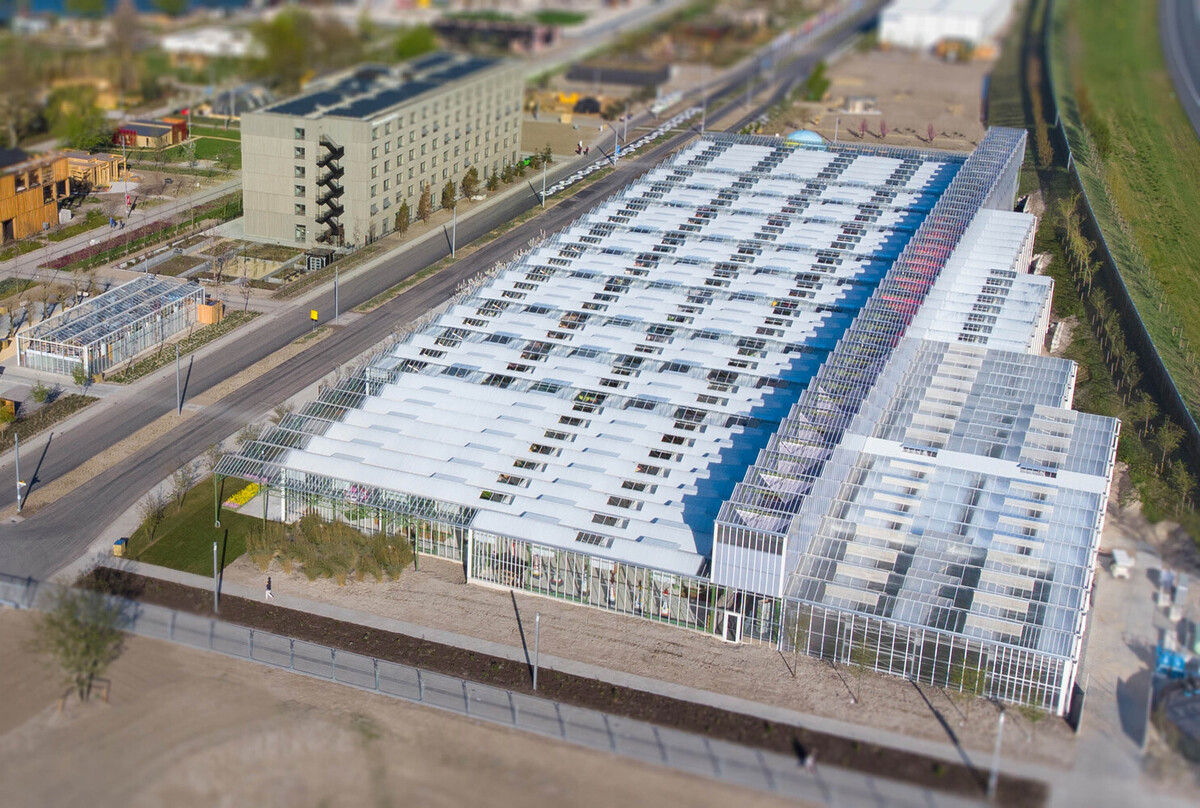
This High Tech architectural design at Floriade 2022 in Almere is called The Green House. Built completely of conventional greenhouse components, the noticeably elevated center axis highlights the structure’s unique purpose. The greenhouse is a temporary emblem of the horticulture industry at the World Horticulture Exhibition because of its size and unique silhouette.
The raised strip in the center of the greenhouse allows visitors to experience the vast scope of greenhouse horticulture systems within one temporary display space. Stretching 170 meters in length, it serves as a promenade and provides visitors with an impressive view of the exhibition floors due to its lofty position.
The Venlo greenhouse type’s reusable standard components are used to build the show greenhouse. This ensures that the greenhouse will be used again after the Floriade. This High Tech architectural design creates a unique play of light and shadow thanks to the use of a variety of materials, including clear, translucent, textured, and even whitewashed glass.
A greenhouse restaurant sits at the end of the promenade, and numerous exhibition zones along it paint a picture of the Dutch horticultural industry. A section of the greenhouse, called the High Tech Green House, will be designed as the pinnacle of modern horticulture. Consequently, the display greenhouse provides professional visitors with an in-depth layer in addition to an incredible experience.
Suggested article to read: Top 21 Biggest Tech Events in the World for 2024
8. Kempegowda International Airport
Architects: HOK
Area: 134000 m²
Year: 2013
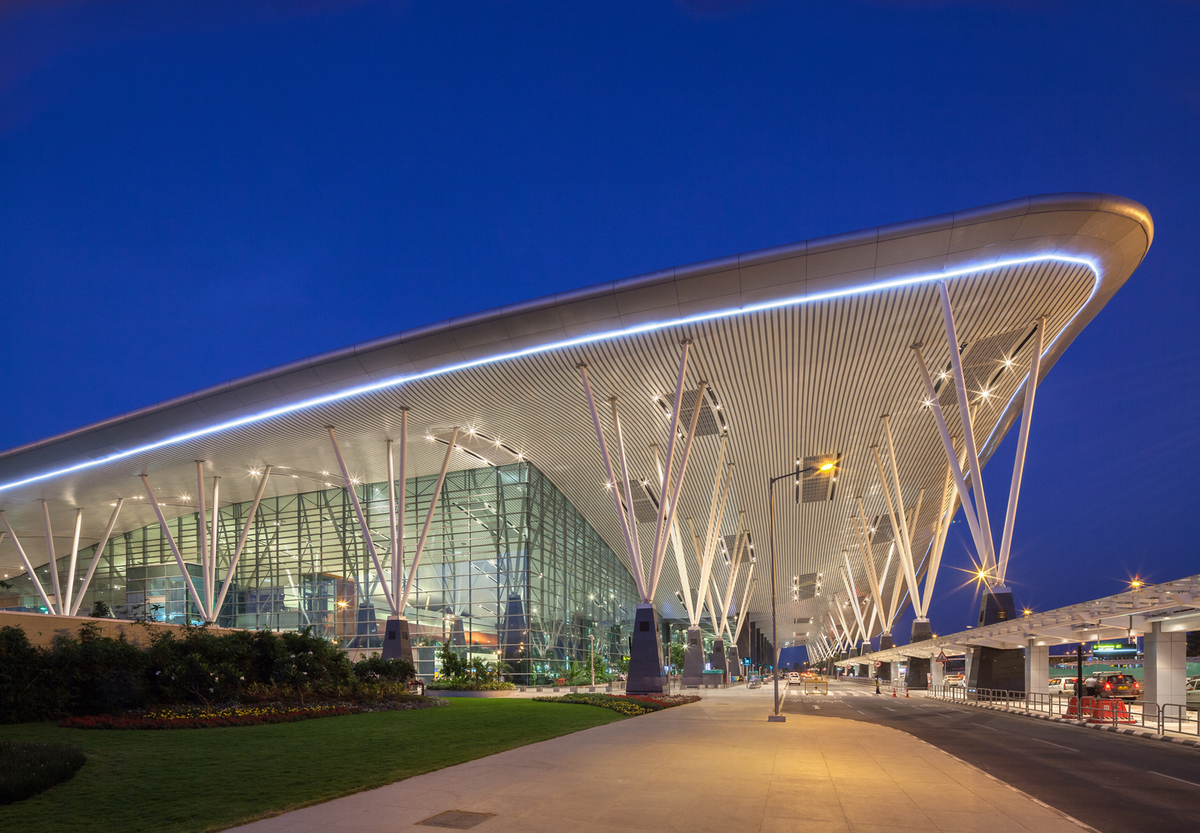
The busiest airport in South India has been repositioned as a major hub for international tourists and freight with the expansion of Terminal 1. The open, friendly atmosphere of the airport is easy to navigate and can handle the growing number of passengers thanks to its quick curbside-to-aircraft customer experience.
Together with the current terminal, the edifice creates a great, dramatic presence. This High Tech architectural design’s gracefully curving roof gives it a strong physical presence and distinctive visual character by acting as the connecting factor between its new and old buildings. The sloping roof creates a cover that shields travelers and passengers from the weather. A monolithic plinth with graceful steel branches that cross a suspended ceiling to meet the structure above is part of its structural system.
Low-e glazing is used in conjunction with this High Tech architectural design’s broad overhang to minimize undesired heat gain and produce an energy-efficient, high-performance structure. By allowing natural light to enter from above, skylights help to connect the old building’s atmosphere and spaciousness with its enlargement. 65-foot-tall glass walls that create spectacular vistas of the outside world and flood the room with natural light are located at the east and west extremities of the terminal.
The High Tech character of the city is recalled through silver metallic and dazzling white finishes. Bengaluru’s interior landscape elements and vegetation contribute to its moniker as India’s “Garden City.” Improved seating sections at gate lounges as well as a range of new culinary and shopping options are among the improved amenities for passengers.
Suggested article to read: Sustainable Construction Technology; Ultimate Guide in 2024
9. Innovation Hunan Conference Center
Architects: DXH Studio
Area: 1700 m²
Year: 2019
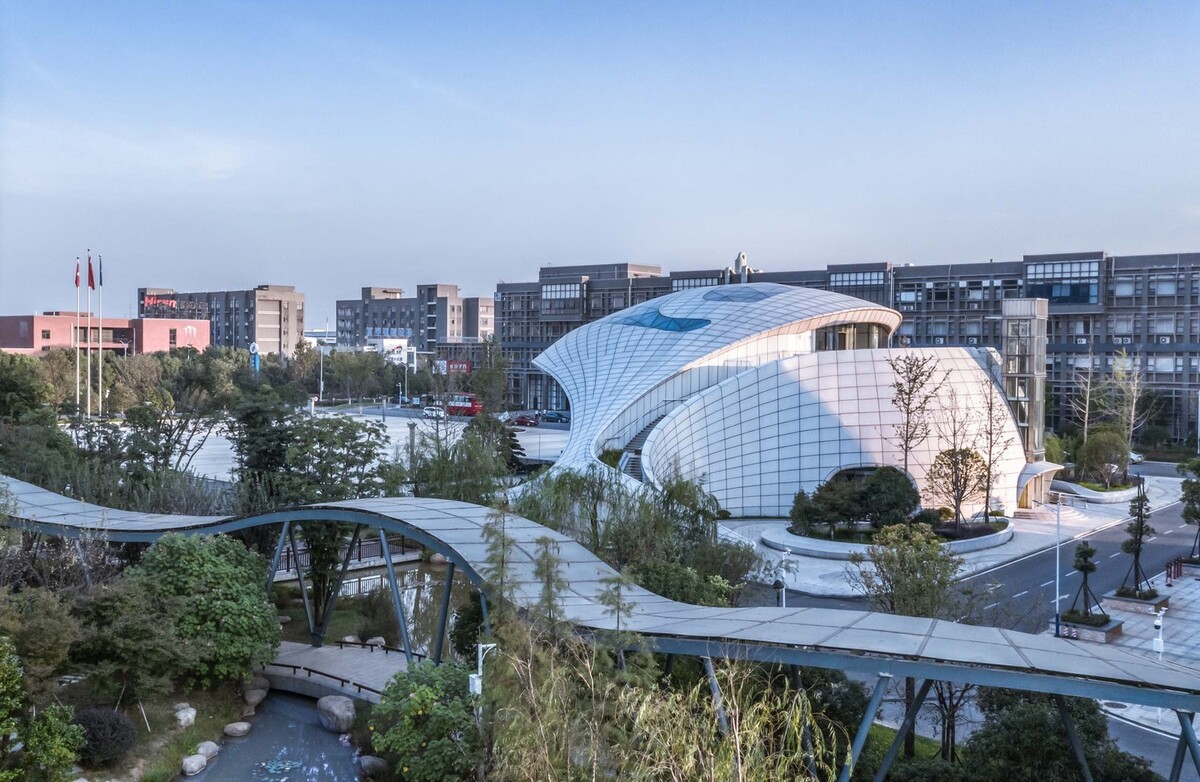
Situated in the High Tech zone of Ningxiang City, Hunan province, the Innovation this High Tech architectural design is part of the Hunan University Student Science and Technology Industrial Park. Park Square is located on the east side of the base, the comprehensive building is located on the northeast side, the entrepreneurship plant is located on the south side, the incubator building is located on the west side, and the mountain park is located on the northeast side. There is a severe shortage of land for construction. The site is roughly 72 meters long from north to south and 31 meters long from east to west.
This High Tech architectural design is located in the park’s conference center and supports a multifunctional public service platform that includes academic exchanges, art exhibitions, roadshows, talent recruiting in the high-tech zone, medium- and large-scale conferences, and art exhibits. Internally, it transforms into the park’s “Shared living room” and serves as a “visual window” to improve the park’s reputation.
The boundaries between indoor and outdoor space, as well as between buildings and landscapes, are ambiguous in the design. The conference center’s building envelopes open up to Jinzhou North Road, the visual center, and other supporting functions, while the mountain park landscape mutually penetrates to form a “Mountain park – conference center – the park plaza” that is once again an independent park space.
Suggested article to read: Top 7 Digital Twin Software in 2024
10. National Heavy Vehicle Engineering Technology Research Center
Architects: CCDI GROUP 21 Design Studio
Area: 1445516 m²
Year: 2022
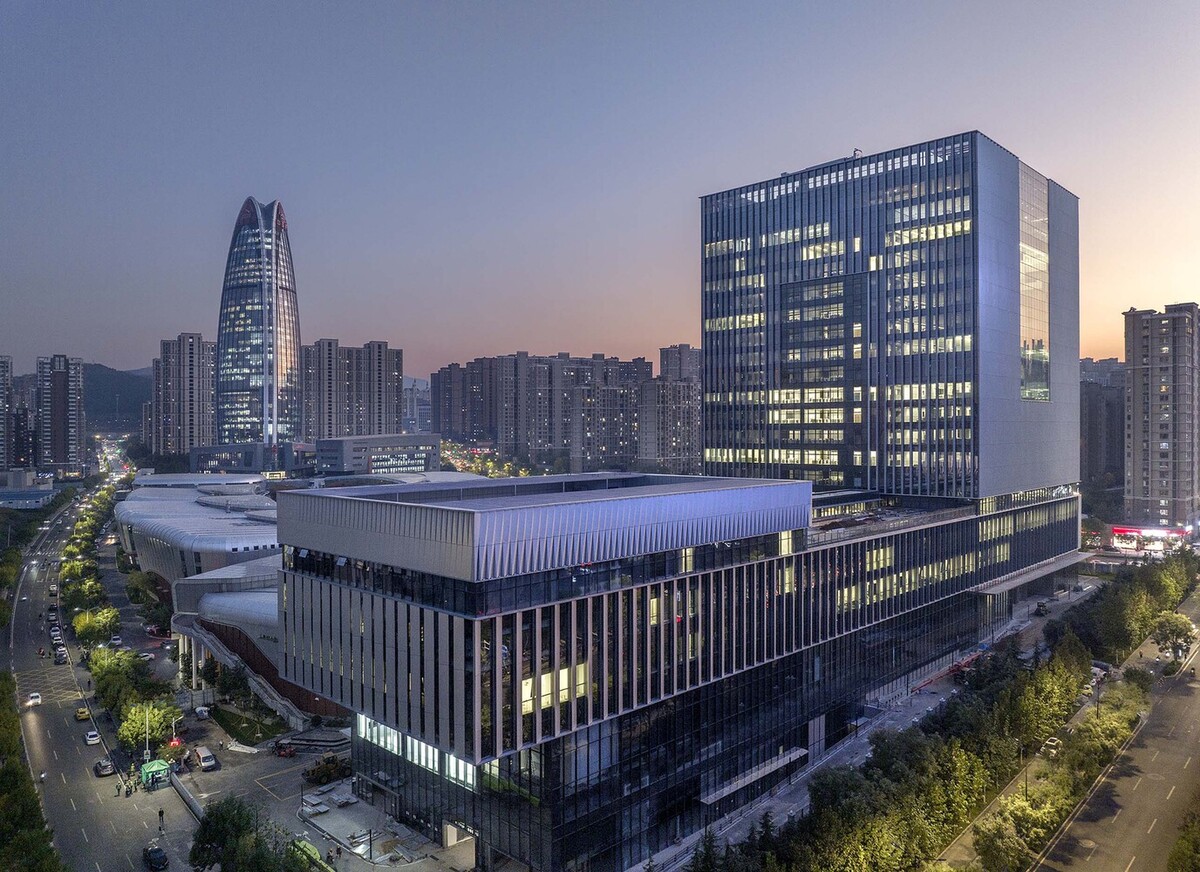
Situated in the heart of Jinan High Tech Zone, between Shunao Park and the northern Hanyu Golden Valley, the National Heavy Vehicle Engineering and Technology Research Center offers easy access to public transit and a pleasant environment. This High Tech architectural design has a total building area of 145516.21 square meters, a tower curtain wall height of 96 meters, and a structural roof height of 89.85 meters. Its total area is 22861 square meters.
The blend of experience and efficiency is shown in the headquarters office. The stark contrast between the opulent interior space and the incredibly basic suspended volume creates a lasting impression in the neighborhood where we previously contributed to the design of the high-rise buildings in Hanyu Golden Valley. By establishing a more vibrant and superior humanized work environment, we seek to foster CNHTC’s innovation and anticipate greater future creativity in this area.
This High Tech architectural design base forms an east-west “L” shape that is long and narrow. The office skyscraper is situated at the Northwest Angle to draw attention to the main picture in terms of functional arrangement. To increase the display area, the enterprise exhibition hall is set up horizontally along the east-west axis. The office tower, which forms a dialogue between the old and new with the first phase of the building, reflects the efficient corporate culture of China National Heavy Duty Truck Corporation. The building’s overall appearance presents a minimalist geometric relationship. The enterprise display hall is located on the first floor of the horizontal podium, with the conference center and restaurant situated above it.
Suggested article to read: 13 Best Architectural Rendering Software; 2024 Review
11. Agrotopia Research Center for Urban Food Production
Architects: META architectuurbureau, van Bergen Kolpa architects
Area: 9500 m²
Year: 2021
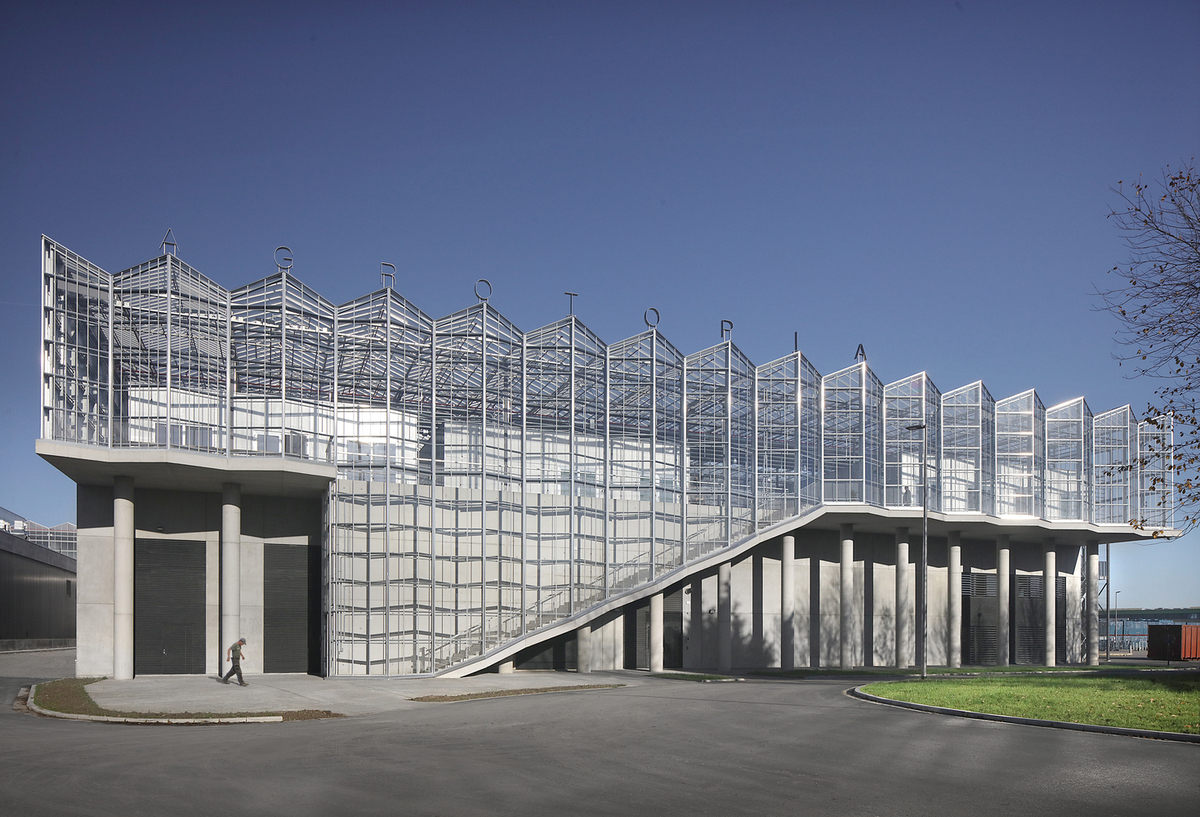
Rooftop garden The largest urban food production research center in Europe is called Agrotopia. This High Tech architectural design gives urban horticulture a remarkable architectural aspect with its faceted glass facades, imposing entrance stairway, and layering of functions.
The creative structure serves as a model for urban food production in the future, efficient use of space, circular energy and water consumption, and increasing the sustainability of greenhouse horticulture. Agrotopia is located in the center of West Flanders’ fruit and vegetable logistics, on top of the roof of the REO vegetable and fruit auction on the Roeselare ring road. Urban horticulture atop industrial roofs is given a prominent role in Roeselare’s skyline with a wonderful perspective of the city and surrounding area.
The 9,500 m2 structure is encircled by a public education trail and has state-of-the-art research facilities for the production of green and fruity vegetables. The Urban Horticulture Square, which has visitor amenities in the center of the building, is accessible through the entry with its broad, stairwell-like staircase. A double-height conservatory for creative vertical cultivation can be found in the ring road facade conservatory.
Rainwater collected from the roof is stored in the foot of the double-height facade conservatory and utilized to irrigate the crops. transparent sculpture. Agrotopia Rooftop Greenhouse is a translucent, glass and steel sculpture. The structure of this High Tech architectural design is a thin, sky-reaching greenhouse that is supported by the concrete container shed base. There is only one typical greenhouse with diffused glass throughout the entire structure.
Suggested article to read: Best Construction Management Software in 2024
12. Promotion Center of High-Tech Park
Architects: Atelier Apeiron – SZAD
Area: 14980 m²
Year: 2019
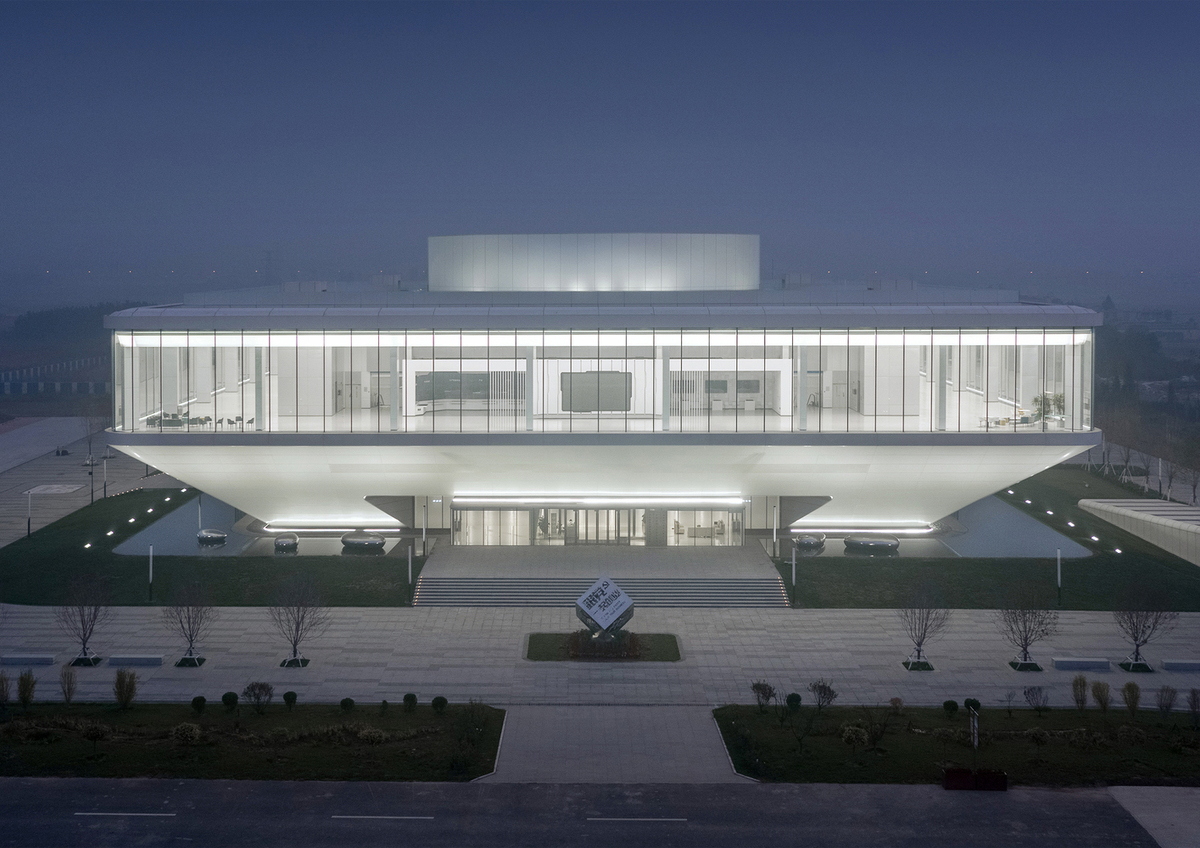
Situated on the periphery of the Xiong’an New District, Baoding is rapidly emerging as a pivotal hub for North China’s industrial and economic growth. Contrary to government aspirations, however, the fact is that the development of new industrial parks necessitates the urbanization of suburban areas to draw and keep more businesses and talent. It is exceedingly challenging to draw in investment and get items in front of consumers, particularly in the early phases of any newly developed industrial park.
They were hired to create the exhibition center for Baoding’s High Tech Park. But as the design took shape, we reassessed the commission and suggested creating a Product Promotion and Business Center with adaptable modular sections that could meet the constantly shifting requirements rather than creating a single-use structure.
To optimize interior space and intricately combine public and private domain, the Promotion middle layouts are round in the middle and rectangular around the periphery. Open display space for various purposes is available on the first and second floors. Another exhibition area is 360 degrees ring-shaped, rising gently 9 meters above the ground, offering the greatest flexibility for a variety of product displays in addition to a panoramic viewing platform for visitors and locals.
As the campus changes, this High Tech architectural design also performs several significant responsibilities. Similar to the campus during its early years, the center serves as a platform for investments for various businesses and as an exhibition pavilion for urban planning. It will soon become an exhibition space for established businesses, a product showroom, a press conference room, and a municipal cultural center that merges with the surrounding park.
Suggested article to read: 15 Best Project Management Software of 2024
13. Tehran Book Garden
Architects: Design Core [4s] Architects & Urban Designers
Area: 65000 m²
Year: 2017
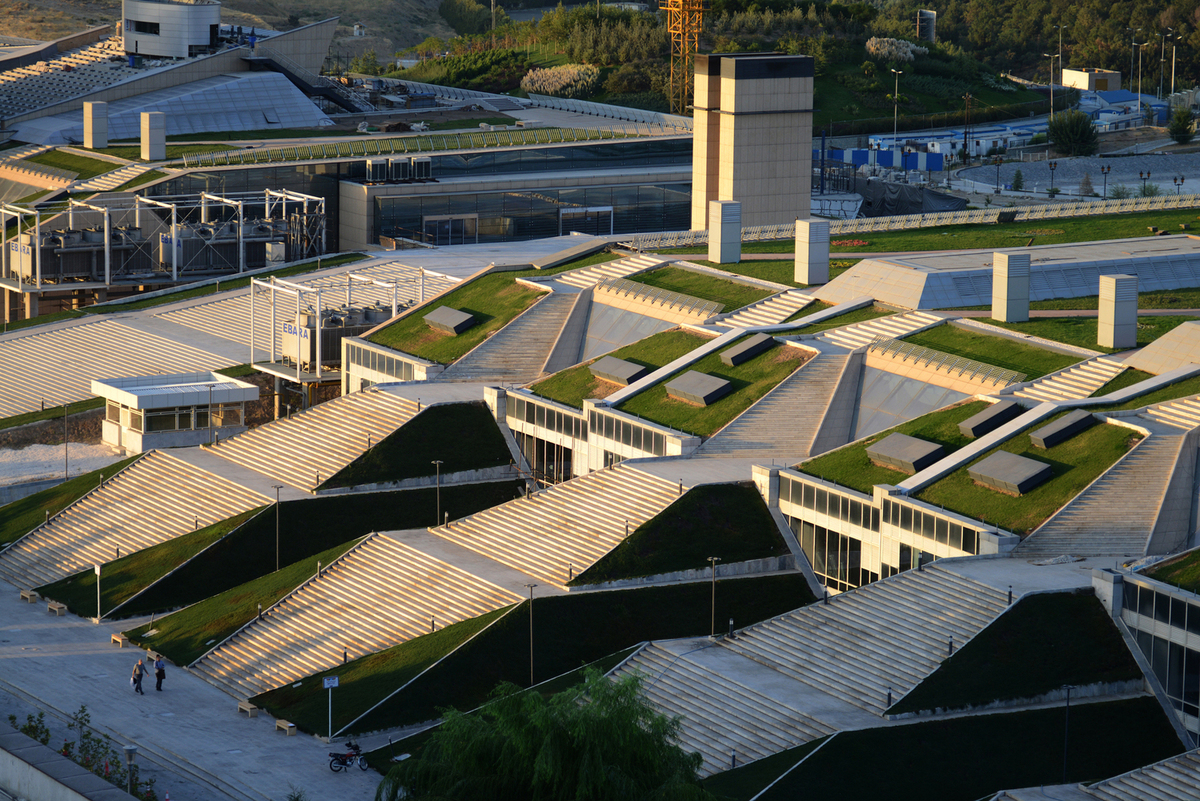
The way that society views book reading may change quantitatively if permanent book exhibition venues are established. This High Tech architectural design was created with this purpose in mind. The 37-acre Book Garden is situated in the Abbas Abbad sector of Tehran’s third district, near other significant structures like Tabiat Bridge, the Iranian Academies Complex, the Sacred Defense Garden Museum, and the Iranian National Library. Book Garden is a mega mall dedicated to books. It features an exhibition area with books and other media on display, a children’s science park, art galleries, a drama theater, theaters and movie theaters, cafes, restaurants, and other outdoor event spaces.
The three primary components that compose the shape of the building are the magnificent western High Tech façade, the interior circulation layers, and the roof’s green covering layers. The master plan of the Abbas Abbad lands places significant emphasis on the implementation of green spaces and environmental conservation.
As a result, we attempted to create a building for this High Tech architectural design that was both in line with the site’s setting and inspired by nature. The main design element that allowed this structure to blend in with its surroundings was the use of a green roof. The roof of the Book Garden project is viewed as a component of nature rather than merely a covering. Something that precisely captures the motion’s continuity.
The Grand Eastern Stairs, which connect the building to the Culture Plaza, National Library, and Academies Complex, lead to the Roof Garden, which serves as a cultural public park. Inspired by the idea of Iranian traditional gardens, this High Tech architectural design’s interior spaces have been designed as one enormous continuous space that functions as a terraced garden.
This High Tech architectural design houses modular exhibition spaces that connect via the main circulation path along the west façade, which is 550 meters long and 13 meters high. Through this glass façade, the inner rooms of the building look out into a 2-hectare artificial lake and the west display garden. A pedestrian walkway known as the “Path of Culture” runs through the middle of the structure.
Suggested article to read: Top 21 Construction Management Company; 2024 Review
14. Gandom Office Building
Architects: Olgooco
Area: 8000 m²
Year: 2019
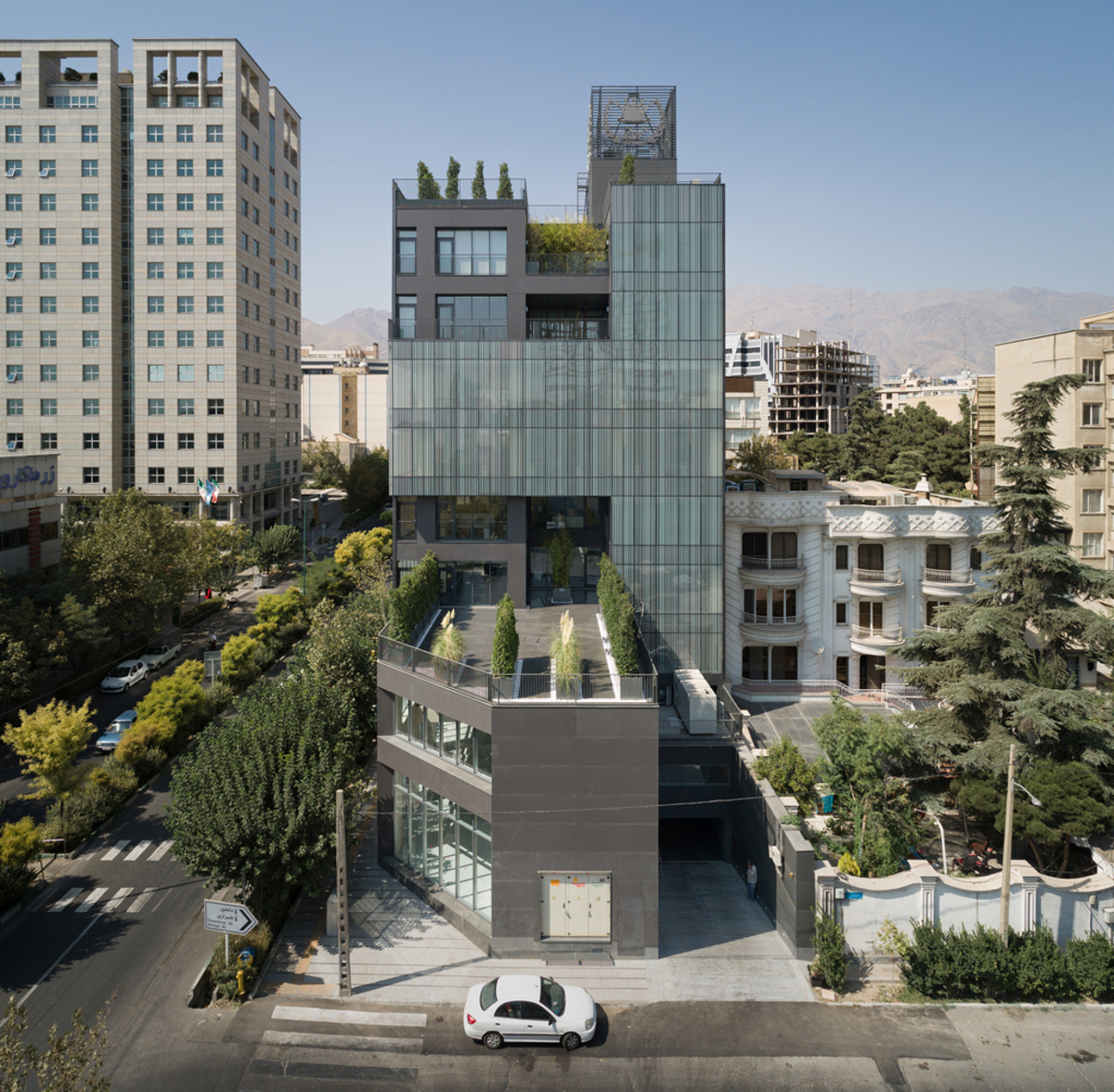
A pasta manufacturing firm had acquired a seven-story office building with a commercial level and seven floors of offices as its headquarters, which was still under construction. They came to us for this High Tech architectural design’s design while the steel framework was being completed, based on fresh physical planning.
The new building’s layout called for common areas such as conference rooms, teamwork halls, high-level manager offices, and management spaces arranged floor to ceiling. To establish a connection between the bottom floor and the city, it was recommended to the client that the commercial space that was previously licensed for the building be converted into a multipurpose cultural area.
A sense of integrity between various functions was established by connecting each section’s public space—which included waiting areas, secretarial spaces, and connecting corridors—to others. That open area was surrounded by the private areas. Consequently, the office space diagram was changed so that a single administration was combined with a sense of attendance on a large horizontal surface in a vertical order. The fundamental framework of the building served as an unchangeable concept and was coated in both organic plaster inside and ceramic tiles outside.
A semitransparent shell with a ceramic printed glass metaphor of wheat stalks was employed on the main network to manage the amount of sunlight that reached the building’s southern and western facades.
Suggested article to read: 101 Essential Construction Terms and Definitions in 2024
15. Flyspot Warsaw
Architects: Biuro Projektow Lewicki Latak
Area: 926 m²
Year: 2015
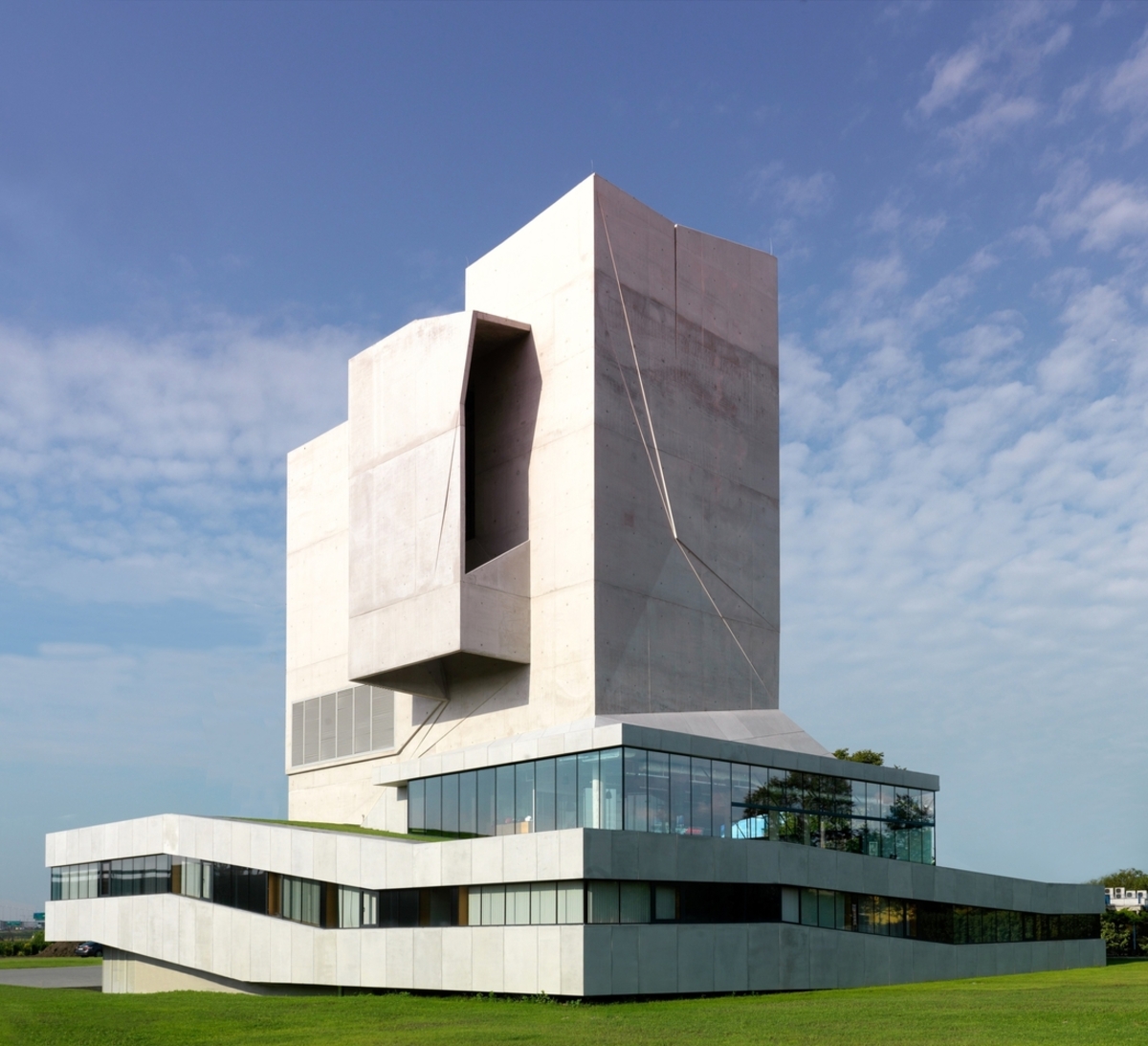
The reinforced concrete structure housing the wind tunnel has varying thicknesses for its walls and ceiling. Measuring 33 m by 22 m at the base and 38 m at the top (11 m above ground level), it has an almost cubic shape.
This High Tech architectural design is made out of an interior solid that is shaped like a cylindrical tube and holds the vertical wind tunnel’s core technology. It is constructed by a square with sides that are 7.5 meters long. Spirally placed around it are the rooms (3 – 4.5 m wide), which include the reception, hotel and office rooms, conference spaces, restrooms, and changing areas.
The glass cylinder, the main feature of this high-tech architectural design, is reached by an inclined tunnel that progressively ascends from the entrance hall. Inside, strong units produce upward-directed airflow at 300 km/h, which enables persons to be raised more than twelve meters. The movement served as a major source of inspiration for the design of this High Tech architectural design’s exterior, as did the associations with “floating” kites and plastic grocery bags (the latter may conjure up less amicable images).
This High Tech architectural design’s shape was also greatly influenced by its location. They were inspired to suggest a unique and independent form by the disorganized urban sprawl at the convergence of the highways, which was only momentarily and fragmentarily apparent upon passing through.
Suggested article to read: Circular Economy in Construction; 2024 Guide
Conclusion
High Tech architectural design uses cutting-edge building techniques and components from emerging high-tech sectors. It was created in Britain in the 1970s using cutting-edge technology and novel construction materials.
The boring conventional construction that was created at the time under the auspices of modern architecture gave rise to this style. The wooden floors and brick walls gave the architecture an air of permanence and antiquity. The unadulterated aesthetics of grain silos and factories, where form followed function, captivated the designers and architects.
The material palette of this High Tech architectural design heavily incorporates steel, glass, aluminum, and, to a lesser degree, concrete. Similar to industrialization, these materials were easily accessible and came in a greater range of forms, particularly when high-tech architecture was emerging. It aimed to blend functionality and beauty by incorporating the building’s technical apparatus into its design.
Internal load-bearing walls are typically absent from this architectural design. Reconfigurable spaces are another essential component of design. Additionally, most buildings have overhanging floors. Some projects utilize bright colors to try to give the impression of a drawing or schematic. For a long time, technology has changed what architecture can do. These days, innovative digital design technologies are revolutionizing the concept and construction of buildings.
Suggested articles for reading:
Zero Energy Buildings (ZEB); Comprehensive Guide 2024
Sustainable Development Goals in Construction Industry; Guide 2024
Top 24 Sustainable Construction Technologies in 2024
Resources:
TheMindCircle | Archdaily | Re-ThinkingtheFuture | RB-Architectes | Autodesk | Medium | Architizer | Novatr
For all the pictures: Archdaily

